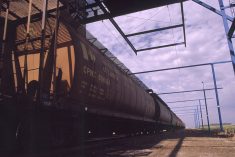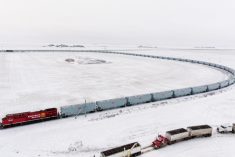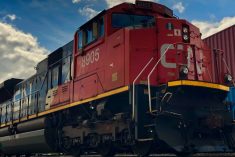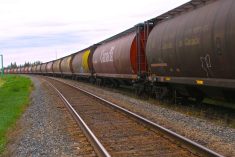Canada’s big two railways have both overshot the maximum revenue they’re allowed to keep for ferrying the 2016-17 grain crop off the Prairies.
The Canadian Transportation Agency on Thursday issued its annual determination of how much, if any, revenue Canadian National Railway (CN) and Canadian Pacific Railway (CP) made over their maximum grain revenue entitlements (MREs) for the crop year.
CN’s Prairie grain revenue came in $5,773,741 over its $802.44 million cap, while CP’s Prairie grain revenue came in $1,078,947 over its $724.38 million limit, the agency said.
CN and CP each have 30 days to pay their overages, plus five-per-cent penalties of $288,687 and $53,947 respectively, into the Western Grains Research Foundation’s endowment fund, income from which is directed to research work.
Read Also

Brazil to reap record soy crop in 2025/2026, increase exports
Brazil’s Conab said the country will reap a record soybean crop of 177.6 million tons in the 2025/2026 harvest year, according to data released on Thursday.
The railways’ combined 2016-17 Prairie grain handle rose 6.9 per cent from the year-earlier period, to 43.2 million tonnes, with an average haul length of 953 miles, up 0.2 per cent, the agency said.
Of that combined grain handle, 31.79 million tonnes moved west to ports at Vancouver and Prince Rupert, while 11.4 million tonnes went east to Thunder Bay or other ports in Eastern Canada.
CN’s total Prairie grain handle for the crop year came in at 22.32 million tonnes, with an average haul length of 1,004 miles, while CP handled 20.87 million tonnes with an average haul length of 898 miles.
CN’s overage for 2016-17 is its fourth in a row, after it topped its MREs by 0.15, 0.9 and 0.7 per cent in 2015-16, 2014-15 and 2013-14 respectively.
CP’s grain revenue came in 0.5 per cent over its MRE in 2015-16, 0.3 per cent over in 2014-15, and 0.3 per cent below in 2013-14.
The annual MREs for CN and CP are calculated each year using a formula based on total grain tonnage and average length of haul as well as the Volume-related Composite Price Index (VRCPI).
The VRCPI is an inflation index accounting for forecast changes in the two railways’ costs for labour, fuel, material and capital purchases.
The 2016-17 VRCPI was set in April 2016 at 1.3275, a 4.8 per cent increase from the previous year, citing expected declines in the Canada/U.S. currency exchange rate, as the railways’ materials purchases are often paid for in U.S. dollars.
For 2017-18, the VRCPI was set last April at 1.3817, up 4.1 per cent based mainly on an expected 3.5 per cent increase in forecast price changes for “railway inputs,” particularly fuel costs. –– AGCanada.com Network














